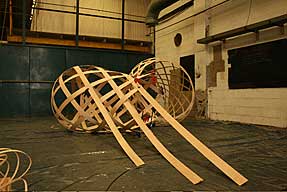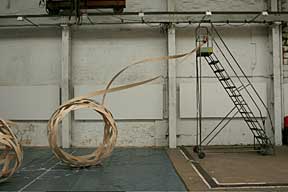Unlikely meeting
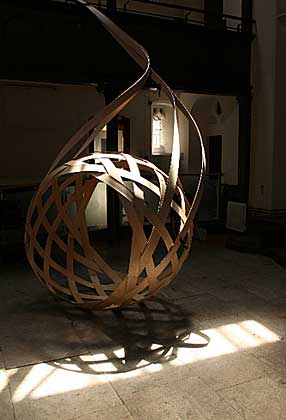
All photos: Annemarie O' Sullivan
Who would have thought an art gallery would be the place for basketry to get to know engineered timber? Cluster has done just that, though, and the process has changed the course of Annemarie O' Sullivan's basket-making path. Here Annemarie talks about the exhibition, her basket-making background, working large-scale, and the pleasures and perils of being introduced to engineered Sweet Chestnut
In an old industrial foundry building along the side of a run down industrial estate, strips of long, thin wood are being bent, pushed and manoeuvred into forms hitherto neither tried nor tested. One ball-like semi sphere hangs from a disused crane track, while on the ground, round, ovoid and vessel like forms are taking shape. These are Annemarie O’ Sullivan’s creations, which shortly after this visit, were moved to Brighton’s Fabrica art space, to go through further iterations of refining and improvement, before her Cluster exhibition project opens in early July 2012.
The exhibition, as this themed edition of Unstructured, makes amply evident, marks the tenth anniversaries of two experimental buildings, the Weald & Downland museum and Flimwell Woodland Enterprise Centre gridshells. Cluster’s woody forms are made from a semi-industrial low grade and engineered wood, glued and ‘finger-jointed’ together, the original development of which was a core part of the Flimwell project’s research agenda. So, this is nothing if not a departure for those involved, not least O’ Sullivan, who’s background is in basket-making and teaching.
It’s also a big opportunity for O ’Sullivan. She had been phoned up, in what must have seemed like an out of blue moment, in the early winter months of 2012 and invited in to Fabrica, to talk about the summer exhibition slot after the original artist scheduled for the exhibition, had had to withdraw due to personal reasons. She went away with ideas buzzing, and at a second meeting presented what she felt were the most exciting ideas. Fabrica’s co-director, Liz Whitehead, liked what O’Sullivan was proposing, large organic ball-like sculptural forms, which would bring presence, scale and a tactile warmth to Fabrica’s deconsecrated church space, and the project was on. It’s a reminder of how chance can change a person’s work and career, quite as significantly as in everyday life. It’s also a step into the unknown for the forty-something O’ Sullivan, who has worked primarily as a basket-maker, with a small number of group exhibitions and private living willow commissions in individual gardens, while dreaming of how she could expand her work across into larger scale, art related pieces for several years.
Exclaiming both excitement and nervousness at this sudden swerve in her work path, the Fabrica exhibition can be viewed as almost an accidental new chapter to O’
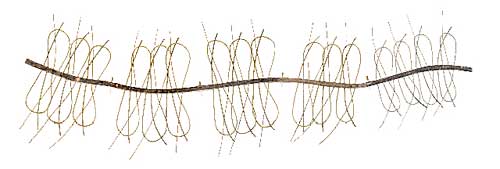
Sullivan’s basket-making journey. This began a decade ago, when she participated in a one-day basketry taster course It sounds like she was immediately smitten, recalling how after the workshop, “I thought I just want to do this,” she says now. Hailing from County Meath, Ireland, O’ Sullivan had first arrived on the mainland to start a course in Sports Science at Loughborough in the nineties, a result of her teenage years spent in and out of water, swimming. She moved to Brighton, teaching at the city’s Buddhist Dharma school, before basketry took over her life. “I became obsessed by it,” she readily admits, talking of how the repetitive, spell-like rhythms of basket-making were similar to the strokes of swimming. “I hadn’t felt anything like it since swimming in my teens. I used to swim for hours and hours. At school I didn’t make things, there wasn’t any craft, so I hadn’t connected.”
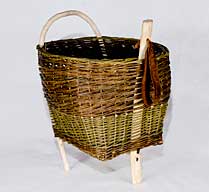
She dove into the world of basketry, intensely and with passion. Much of this was initially exploring living willow, though as she learnt different basketry techniques both repertoire and materials expanded into other woods in the green woodworking tradition: ash, oak, hazel. The next course followed with Sussex basket-maker, Steyning based Jackie Binns, “she was very, very encouraging, saying yes to everything, to any idea, to exploring, playing and experimenting. Through this time she researched, she says, as much as she could about the subject. This would include seeking out French basket-makers in the Pyrenees “much closer to the source of the tradition,” local basketry authorities in the South East, such as
Mary Butcher and Sue Chaplin; and after finishing studying with Binns in 2006 beginning a five year part time basketry course at the City & Guilds Centre in London.
The baskets and other small artefacts began selling, while O’ Sullivan’s skills, knowledge and dedication, gradually became known about within the relatively small world of basketry, particularly in Sussex and the South East. This turn to a tradition of making follows a pattern recognised about basketry over the last three decades. It is a craft, which, unusually, is enjoying renewal. The skills, the visceral experience of making, and the slow qualities of attention, that accompany this making, have been drawing people – in the main, it seems, women - into learning basketry skills, doing courses, and becoming makers. The revival has been growing over the last quarter of a century. The main body, the Basketmaker’s Association, which was founded in 1975, continues to expand, with a current membership numbering a 1000 plus. Over these years, older practitioners have become influential and inspiring, such as Mary Butcher and
Lois Walpole. Courses have appeared, and multiplied, with a steady flow of students signing up. Some stay the course and take it further than others, but the overall replenishment of makers has continued. O’ Sullivan is a good example of a small minority who take the craft to their hearts and make a working life out of their love of basket-making.
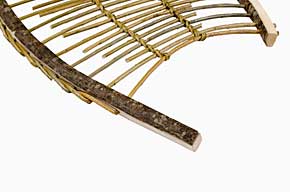
“Trying to make a living is just so difficult and so challenging,” she says now, a key aspect of a further critical boundary line that splits the world of basket-making into two. It’s true, that those drawn to basketry as this resurgence gathered pace, have overwhelmingly done so because of renewed interest about the traditions of the craft and its centuries as a rural working tradition. Still, there remains on one side a small, and - in Britain at least – diminishing group of ‘old school’ basket-makers who look upon their craft as functional and utilitarian, and view their work as upholding this tradition. Once, not so long ago, every town and village had their basket makers, which is what these few remaining crafts people are trying to keep alive. Today, in Britain and other Western countries this original basket-making tradition has been increasingly marginalised, either in the midst of disappearing or extinct, or on the verge of becoming so. In the developing world and the less Westernised parts of Eastern Europe, Modernity and Modernisation haven’t yet wreaked their full destructive side of their potential on these – and other – learnt knowledges of the body, so that pockets of traditional rural, utilitarian craftsmanship remain. Against this disappearing tradition, in recent decades a significant number of practitioners, in Britain and internationally, have also expanded from the purely functional to using basketry as the ground for exploring the aesthetics of form; with the craft turning towards a new identity; that of an art form. Lois Walpole, who became involved in basketry in the eighties, was particularly influential in introducing sculptural elements, as well as new, non-traditional materials, coming as she did from a fine art background. It became the new, originally experimental basket-making terrain and is the other side of the invisible boundary. Today, there are a substantial number of practitioners both in Britain and internationally, who have developed careers from crafting beautiful, though non-functional objects; sculptures in effect. Here the basket is a source for a sculptural exploration of form. Practitioners are diverse and the resulting forms many, even if the starting point is the space holding vessel. Take, for instance,
Lizzie Farey spare willow woven art baskets;
Tim Johnson’s multidisciplinary experiments with materials encompassing kelp, willow and other woods, and
Lise Bech, whose vase-like sculptural forms edge towards a Modernist minimalism. Those are only three examples in an international network, which is also identified
through scale, a continuum encompassing large and small. Large-scale work also merges, in a seemingly invisible crossover, into the overlapping terrain of land art, for instance in the work of
Uneo Masao, and Chris Dury the Japanese and British artists respectively. At the other end of the scale, basketry moves towards the miniature realms of jewellery, such as the small boxlike interior worlds of Edinburgh based,
Anna King. O’ Sullivan, freed to play by the Fabrica commission, has gravitated – naturally – to the expansive end of the spectrum.
Almost without exception the connecting thread, whether artist, crafts-person, or crossover in-between, is one of close relationship to the natural world. It’s a relationship which is close to the source of what has drawn each towards their practice, with nature as core inspiration and influence to these craftsmen and craftswomen exploring, and exploiting, the different techniques of basketry. For O’ Sullivan, there’s no exception to this influence of the natural. “I connect it with the landscape here in the Sussex Downs. It’s a surprise to me since I was brought up in a Nationalist community to be very anti-English.”
Cluster does, however, contrast with this these traditions, because of the conditions that the Fabrica project brought with it. No-one up to this juncture in either the loose continuum encompassing the sculptural application of basket making techniques and those identified as land art related has used the semi-industrial timber construction material O’ Sullivan is experimenting with. Nor, to turn the point upside down, has the architectural community experimented with low-grade engineered timber for sculptural ends. It is a departure which is wholly new, (particularly, as the original artist’s early preparatory work, suggested they weren’t going to pursue this engineered timber option) though one O’ Sullivan has approached with openness and enthusiasm. There have been challenges and problems to work out and deal with along the way of its making, but
Cluster demonstrates basketry venturing into the field of industrial materials, to all these varied constituencies.
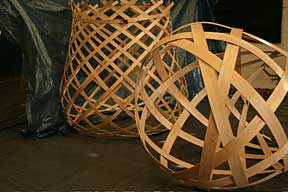
How the experiment pans out will be interesting. “I really enjoy making with my whole body, I love to work on this scale,” O’Sullivan exclaims during the Foundry space visit. Yet it’s too early to know whether she will use the material again, let alone explore other experiments. She says she is keen and ideas are fizzing away in her mind, but will there be the opportunities? And given O’ Sullivan’s long background in willow and living materials, what degree of appeal will it maintain in the future? Especially as the knowledge, which comes with the annual growing, coppicing and harvesting of willow wands, is “a big part of it,” she reflects, while also liking “it more if it reflects really good craftsmanship.” As part of the City & Guilds course, she found she learnt much more about understanding wood than she’d anticipated. This included learning to read the signs on the surface of individual woods, knowing the hints of particular individual properties hidden in inside, “you have to open the book to savour its contents.” At the beginning it sounds as if she didn’t have much idea of the basics of weaving, describing early efforts as not dissimilar to episodes of Fawlty Towers. Determination seems to have kept her going, gradually becoming competent and then skilled at a variety of basketry techniques, plus learning to make trugs and ash chairs, and green woodworking techniques with a Lewes based green woodworker, Danny Harling. The City & Guilds course seems to have been a period for a re-assessment of sorts; carrying out research, and becoming more conscious of which basketry paths were most important for her, noting in her final written essay that splitting and heating became her core significant basketry techniques. Some of this time was spent dipping her toes into the vast, albeit disappearing basketry traditions, visiting various collections and seeking out old basket makers in different parts of Europe. Up till
Cluster she hadn’t worked with sweet chestnut, although a research visit to the Pyrenees’ uncovered chestnut-based basketry in the Pyrenees, where it is widely used, including that of Lluis Grau, (www.casa-dos-artesans.com/aboutus.htmla) Catalonian basket-maker.
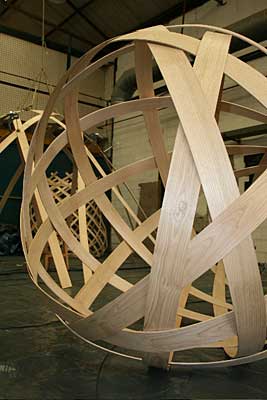
Again and again, what is repeatedly striking about O’ Sullivan involvement with basketry, is the level of passion and immersion, her ‘small obsession’, she calls it, which seems so against the grain of the mainstream of the generation she is part of. The City & Guilds course seems to have helped her focus, and reading the final project essay, it is clear that she feels that after the first ten years she is only just beginning. She writes: “I often describe my journey into basket making like learning to read. I have just mastered the alphabet and realise how many books there are in the world.” This is such a vivid contrast to the majority of, often urbanised, younger generation, who not only don’t know a first thing about rural skills and traditions, and, almost more alarmingly, neither see nor care why their disappearance could be significant.
She proffers an impassioned commitment to the traditional side of the divide, “I’m absolutely committed to the techniques, and the skills and getting this spot on. But in itself it isn’t enough for me.” The
Cluster exhibition is enabling her to experiment with an art project, one firmly on the side of the non-functional. Perhaps her willingness is to do with her youth. While there is a substantial community of established basket makers mining the art dimension, by comparison it seems to be the complete exception among the younger generations.
Laura Ellen Bacon, a contemporary of O’ Sullivan’s, who is becoming known for her sculptural work, but she appears to the exception proving the rule. Bacon also went through an applied art course, and doesn’t have a background in basketry itself. At present O’ Sullivan would like to work, she says, with the industrial finger-jointed chestnut further. She also notes how it also, in its own way, has an unpredictability that compares with greenwood. “Each piece is individual, you don’t know how it is going to work.” By being thrown into the deep end with Cluster, it could be that such experiments with a contemporary of-the-moment semi-industrial engineered wood will speak to others of her generation, and a door will have been gently opened for other younger artists, architects, basketeers, carpenters or whoever to try their hands at such a mix of old and new.
Chance is a strange thing. Six months ago, the use of the low-grade chestnut wood seemed unlikely to happen. Alongside propelling O’ Sullivan into working on large-scale woven forms,
Cluster will hopefully also feed others of her generation and younger, with the excitement to explore the possibilities of working the boundaries between natural, non, and engineered wood.
 All photos: Annemarie O' Sullivan
All photos: Annemarie O' Sullivan


